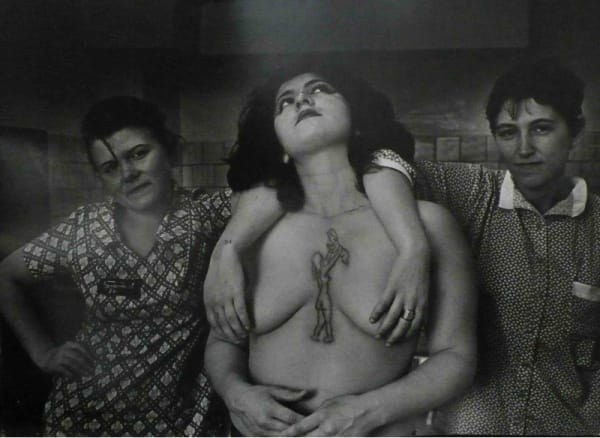Sergei Vasiliev: Russian Criminal Tattoos
Past exhibition
Works
Overview
Bodies as Text Sergei Vasiliev
Between 1948 to 2005, 3,000 drawings were compiled by prison warden and ethnographer Danzing Baldaev of the tattoos of the inmates. Supported by the KGB, who recognised the usefulness of such a document, these drawings were supplemented by photographs by Sergei Vasiliev, a fellow warden.
In 2003, the publisher Fuel began repackaging the sketches and photographs into the Russian Criminal Tattoo Encyclopaedia. The Michael Hoppen Gallery is pleased to announce an exhibition of Vasiliev’s photographs from this fascinating archive.
The motifs depicted represent the uncensored lives of the criminal classes, ranging from violence and pornography to politics and alcohol. Sergei Vasiliev's graphic and unflinching photographs show the grim reality of the Russian prison system and some of the characters that inhabit it. Malnourished, defiant, preternaturally aged and pensive, the photographs evoke a sense of compassion for the convicts despite the brutal crimes many of them committed.
The tattoos depicted are a language in themselves, comprising of a rich array of symbols and illustrations that denoted a prisoner's crimes and political allegiances, as well as his or her rank in the prison hierarchy. Prisoners typically applied them to each other — not always with consent — using inks improvised from soot, sugar, ashes and urine. Vasiliev’s black-and-white photographs are an important document of Baldaev's illustrations, designed to confirm their authenticity, but becoming something much more- humanizing the hardship and heartbreak behind the bravado of the illustrated flesh.
Russian criminal tattoos have, in some small but significant way, begun to infiltrate and influence the Western ideas of Russia at its most secret and dangerous. In recent years, they have been depicted in David Cronenberg's film "Eastern Promises" and in Martin Amis' novel of the Great Terror, "House of Meetings."
The motifs depicted represent the uncensored lives of the criminal classes, ranging from violence and pornography to politics and alcohol. Sergei Vasiliev's graphic and unflinching photographs show the grim reality of the Russian prison system and some of the characters that inhabit it. Malnourished, defiant, preternaturally aged and pensive, the photographs evoke a sense of compassion for the convicts despite the brutal crimes many of them committed.
The tattoos depicted are a language in themselves, comprising of a rich array of symbols and illustrations that denoted a prisoner's crimes and political allegiances, as well as his or her rank in the prison hierarchy. Prisoners typically applied them to each other — not always with consent — using inks improvised from soot, sugar, ashes and urine. Vasiliev’s black-and-white photographs are an important document of Baldaev's illustrations, designed to confirm their authenticity, but becoming something much more- humanizing the hardship and heartbreak behind the bravado of the illustrated flesh.
Russian criminal tattoos have, in some small but significant way, begun to infiltrate and influence the Western ideas of Russia at its most secret and dangerous. In recent years, they have been depicted in David Cronenberg's film "Eastern Promises" and in Martin Amis' novel of the Great Terror, "House of Meetings."



